Unveiling The Secrets Of Prasat Kravan On Your Angkor Trip 2026
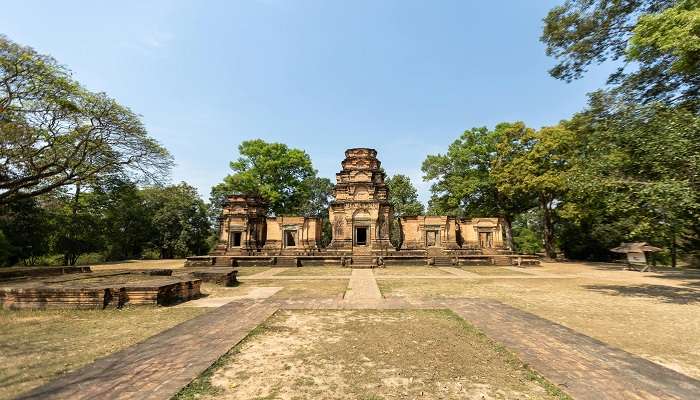
Just imagine yourself among the ancient ruins of Angkor in Cambodia. Great towering sandstone temples dominate this landscape. One of the hidden gems amongst these temples is Prasat Kravan. It has five reddish-brick towers clustered together on one terrace. Prasat Kravan may not be as massive as Angkor Wat or Bayon, but it offers an enthralling look at the grandeur and artistic brilliance of Angkor. The “Preserver,” Vishnu, is honoured in Prasat Kravan, whose true magic lies inside its intricate carved interiors. Let us delve deeper into the amazing world of Prasat Kravan to find out what lies ahead.
Prasat Kravan History
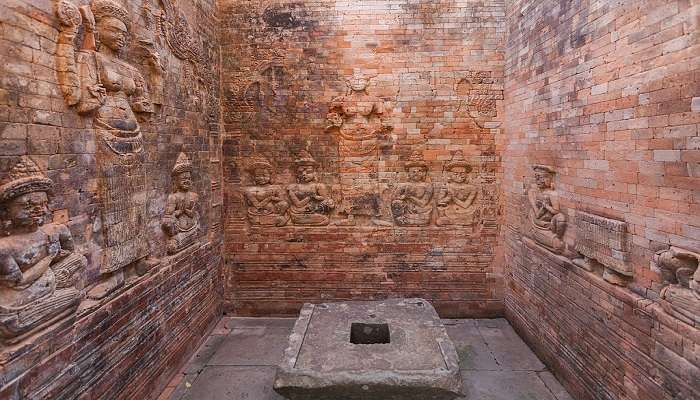
Prasat Kravan history reveals that the temple was dedicated to Lord Vishnu in 921 CE. It is believed that the temple might have been built by high-ranking officials of either King Harshavarman I or Ishanavarman II. The temple is found away from major royal complexes which support this theory. It is believed that the temple was abandoned around the 16th century. Angkor’s treasures were rediscovered in the 20th century. French explorers Georges Trouve and Henri Marchal began clearing the site during the 1930s but their work was interrupted by World War II. Only in the 1960s did Bernard Philippe Groslier and his team decide to undertake a major restoration effort of Prasat Kravan to be visited again.
Must Read: Temples In Cambodia
Prasat Kravan Towers
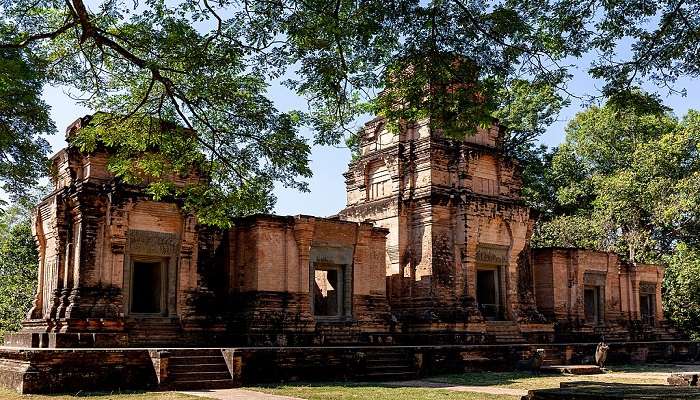
The most distinctive feature of Prasat Kravan has always been its five brick towers placed in a straight line. The towers face east, which represents the rising sun and spiritual enlightenment. Unlike many Angkorian temples built from sandstone, Prasat Kravan’s use of brick is unique.
There are three intricately crafted bas-reliefs in the central tower, which depict various forms of Vishnu. Here you will find his eight-armed image on the back wall. On the left wall there is an image depicting three giant steps showing a symbolic act of taking over the world again and the image on the right wall shows him sitting on Garuda. These images give an insight into Hindu mythology about Lord Vishnu.
The walls of the northernmost tower are adorned with the carvings of Lakshmi, Vishnu’s consort. One image shows her holding both Shiva’s trident and Vishnu’s discus which could be taken as a possible explanation of her as a unifying force beyond deities’ boundaries.
Prasat Kravan: Quick Travel Guide
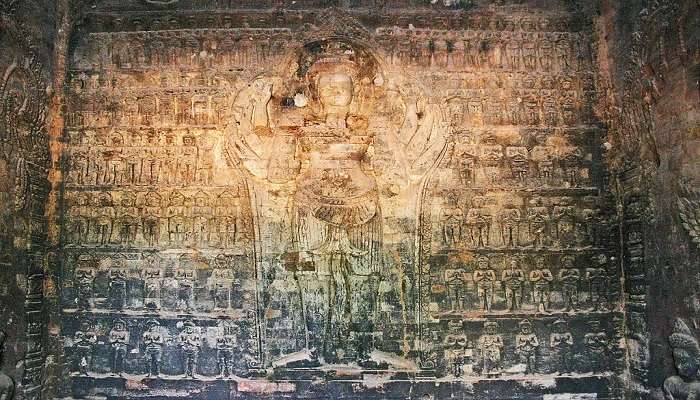
Prasat Kravan Location: Prasat Kravan is conveniently located within the Angkor Archaeological Park, between magnificent Angkor Wat in the west and the serene Srah Srang lake in the northeast. It’s situated along the Grand Circuit, a popular route encompassing many of Angkor’s most significant temples, including Angkor Wat, Bayon, and Ta Prohm.
Prasat Kravan Temple Timings: Prasat Kravan is open for visitors every day between 5:00 a.m. and 6:00 p.m. However, early morning or late afternoon will provide a peaceful atmosphere alongside beautiful conditions for photography, where you can take lovely pictures of the temple’s reddish brick towers.
How to Reach Prasat Kravan: If you are in Siem Reap, the city that serves as a major gateway to Angkor, hiring tuk-tuk will be the best means of reaching Prasat Kravan. You can also negotiate the prices and tour the entire Angkor circuit in tuk-tuk itself. Alternatively, you can hire a personal vehicle to explore at your own pace and have complete flexibility.
Suggested Read: Shopping In Siem Reap
Prasat Kravan: Nearby Attractions
Prasat Kravan is located within the sprawling Angkor Archaeological Park, making it a perfect starting point for further exploring other majestic temples. This park houses numerous temples, each with an individual story and architectural wonder. Here’s a breakdown of some nearby attractions you can’t miss:
1. Angkor Wat: A Celestial Abode
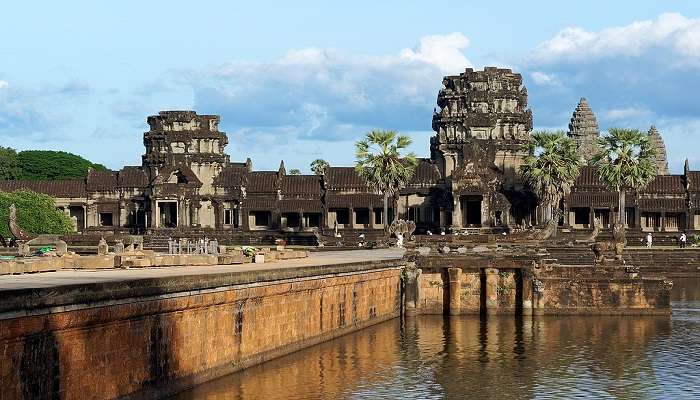
The enormous complex of Angkor Wat reflects the architectural brilliance and religious devotion of the Khmer Empire. Constructed in the XII century under Suryavarman II, it is dedicated to Vishnu, who is regarded as a Hindu deity responsible for preservation. The design element of Angkor Wat represents Mount Meru, which is considered home to Hindu gods in mythology. The detailed carvings on the walls show different scenes from Hindu mythology, daily life during that era, and even battles fought by King Suryavarman II. The temple remains an attractive symbol of magnificence within Angkor and it is regarded as a UNESCO World Heritage site drawing millions of tourists every year.
2. Bayon: Temple Of A Thousand Smiles

Bayon is situated right at the centre of Angkor Thom and is popularly known for its mysterious “Bayon faces.” Bayon was constructed by King Jayavarman VII between the late 12th and early 13th centuries AD and reflects both Mahayana Buddhism and Hinduism. There is no doubt that 217 enigmatic faces are what makes Bayon attractive. With mild smiles and half-closed eyes, these faces look quite peaceful offering calmness and kindness. The temple layout consists of three concentric enclosures, each with a set of towers richly decorated in bas-relief. These carvings depict different scenes from Angkorian life, such as markets, military processions, and religious rituals. Exploring the corridors is a way of seeing how Khmer society practised its religion when it ruled the empire.
Suggested Read: Museums In Siem Reap
3. Ta Prohm: Temple Reclaimed By Nature
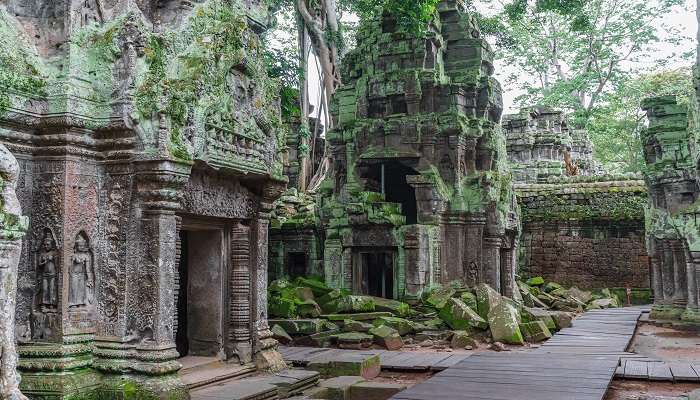
Ta Prohm is also called the “Tomb Raider Temple”, where one of the famous movie series was filmed. Unlike other Angkorian temples which have been meticulously restored, Ta Prohm has been left in its original state. Built between the late 12th and early 13th centuries by King Jayavarman VII, Ta Prohm was initially a Buddhist monastery. The temple complex is an eclectic mix of architectural styles highlighting Hindu and Buddhist influences. Great kapok trees have wound their roots tightly around the temple walls, making it a marvellous site. Vines creep through doorways while huge tree trunks pierce courtyards. It’s the connection between nature and architecture that gives this place its special charm.
4. Pre Rup: A Majestic Mountain Temple
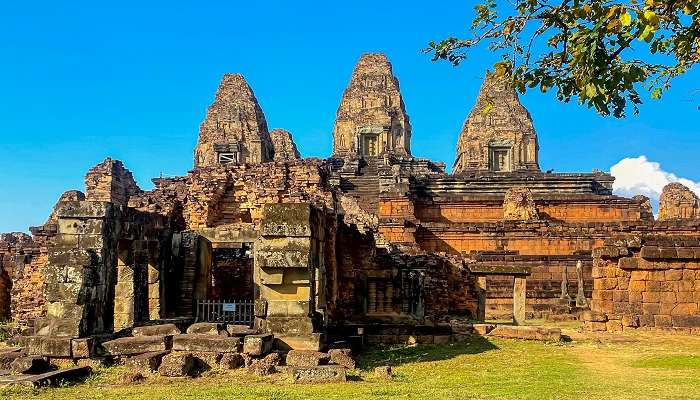
Pre Rup is a temple pyramid of the 10th century that stands on top of a three-tiered laterite platform. It is located to the east of Angkor Wat and provides an amazing outlook of the surrounding Angkor landscape. This particular complex is dedicated to Lord Shiva. In order to get into its central shrine, you need to climb up along steep stairways made from laterite with lions’ sculptures on each side. Bas-reliefs covering walls around Pre Rup provide valuable information about rituals performed here. These carvings portray different scenes, including offerings made before deities, dancers and mythological stories, among others. Pre Rup is quieter than some of the larger Angkor temples.
Suggested Read: Trekking In Siem Reap
5. Banteay Kdei & Srah Srang: Serenity Amidst History
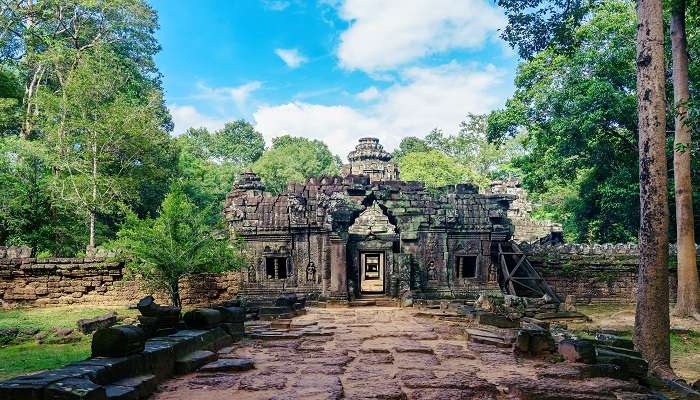
Banteay Kdei is a Buddhist monastery complex located just east of Prasat Kravan, dating back to the late 12th and early 13th centuries. The broad compound consists of four symmetrical enclosures, each with laterite walls surrounding them. These courtyards house tall towers and sculptures within their enclosures. Delve among intricate bas-reliefs illustrating scenes from the Buddhist-mythology which includes Buddha’s life and tales from Jataka. To the east of Banteay Kdei lies Sra Srang, a large artificial reservoir that once supplied water to the Angkor civilization. This vast stretch of water, over a kilometre in length, was used for crop irrigation, transportation, and religious ceremonies. Banteay Kdei and Srah Srang provide a glimpse into the religious and social life of the people in the Angkorian period especially if one visits them together.
Further Read: Romantic Places In Cambodia
Prasat Kravan is an unseen treasure hidden amidst the magnificent Angkor. If you are a history buff, art enthusiast or just anyone looking for some peace within the vast expanse of Angkor, then Prasat Kravan will not disappoint you. Plan your trip to Cambodia and get ready to be amazed by architectural marvels as well as cultural treasures lying ahead.
For our editorial codes of conduct and copyright disclaimer, please click here.
Cover Image Source: pexels
Frequently Asked Questions About Prasat Kravan
How much time does it take to explore Prasat Kravan?
It will take around 30 minutes to an hour for you to explore the temple. But if you want to take pictures and read information boards then it will take additional time.
Can I climb the towers of Prasat Kravan?
It is not allowed to climb the towers of Prasat Kravan because of safety reasons.
Is Prasat Kravan crowded?
It is less crowded compared to other temples so you can move around in peace.
What should I wear while visiting Prasat Kravan?
Consider wearing clothes that cover your shoulders and your knees.
Should I hire a guide while visiting Prasat Kravan?
It is not necessary to hire a guide but if you want to know the historical perspective or understand the meaning of various carvings inside the temple then it is a good option.
People Also Read:

Innovative Content Writer Focused on Producing High quality, Original Content that drives traffic and engages readers. Experienced in Content strategy and analytics to measure content performance using tools such as SQL, Power BI, Excel.











